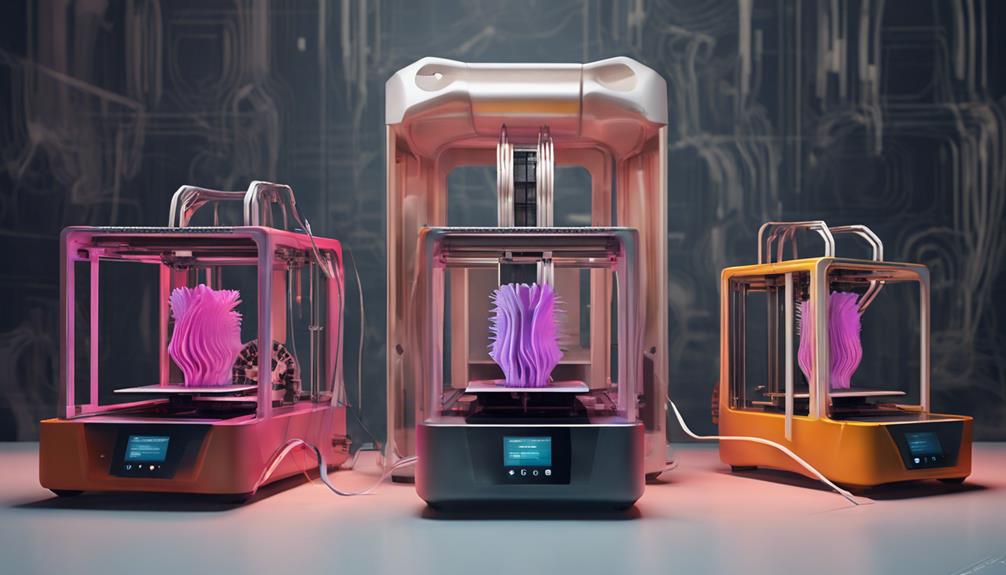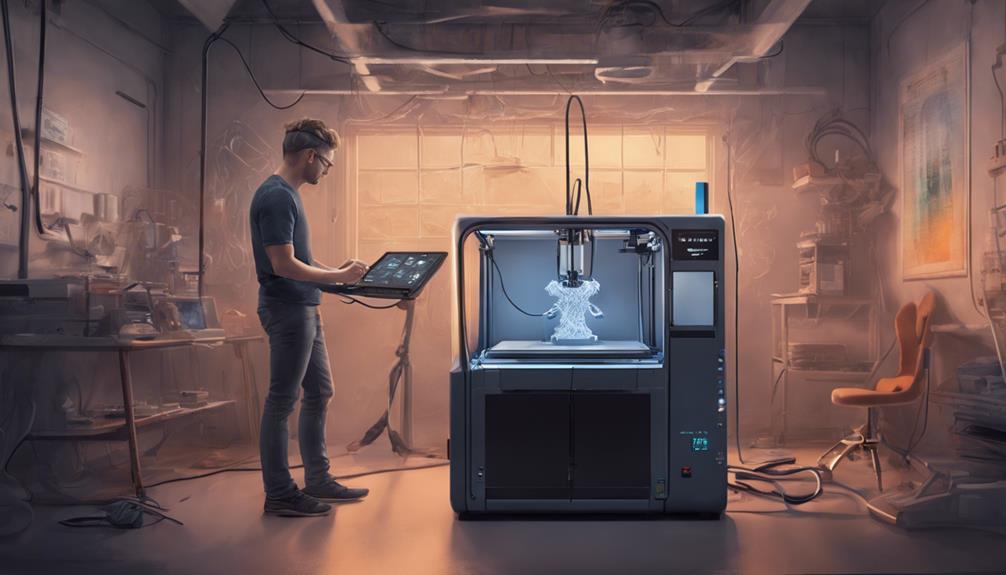As you observe your 3D printer humming away, have you ever considered the decibel secrets it holds? The world of 3D printing reveals a fascinating range of noise levels, but what if you could uncover ways to make your printing sessions more tranquil? From understanding the impact of different components on printer noise to exploring techniques for noise reduction, there's a whole domain waiting to be explored. Discover how you can transform your printing environment into a quieter oasis and elevate your 3D printing experience to a whole new level.
Noise Levels of Different 3D Printers

When considering the noise levels of different 3D printers, it's essential to understand the range of decibel outputs across various models. FDM 3D printers typically produce noise ranging from 45 dB to 62 dB. Cheaper models like Creality Ender 3 and Artillery Genius operate between 56 dB and 60 dB.
Quieter options such as Prusa I3 MK3, Dremel Digilab 3D45, and Flashforge Adventurer 3 are less noisy, ranging from 45 dB to 50 dB. Resin printers like Elegoo Mars 2 Pro emit noise around 50 dB, while louder models like Elegoo Saturn or Anycubic Photon can reach 54 dB.
Understanding these decibel ranges will help you choose a 3D printer that aligns with your noise tolerance levels.
Impact of Components on Printer Noise
To grasp how different components impact the noise levels of 3D printers, one should take into account the role of fans, stepper motors, and printer vibrations. Fans, especially those cooling the hotend or the print bed, can generate considerable noise. Upgrading to quieter fans or installing fan silencers can help reduce this noise.
Stepper motors, responsible for precise movements, can also contribute to the overall noise level. Opting for stepper drivers with higher microstepping capabilities or dampening mounts can mitigate stepper motor noise.
Additionally, printer vibrations can amplify noise levels. Using anti-vibration pads or placing the printer on a stable, vibration-resistant surface can absorb these vibrations, leading to a quieter printing experience.
Techniques for Noise Reduction

For reducing noise levels in 3D printers, consider upgrading components like fans, stepper motors, and mainboards.
Upgrading to quieter fans can make a noticeable difference in reducing the overall noise output of your printer. Changing to more silent stepper motors can also help minimize the operational sounds. Another effective technique is upgrading to a quieter mainboard, which can contribute to a significant reduction in noise levels during printing.
Additionally, non-modifying solutions like creating a soundproof enclosure, using vibration dampening feet, or incorporating anti-vibration pads can further help in reducing noise. Implementing these techniques can enhance your printing experience by making it more pleasant and less disruptive.
Quietest 3D Printers on the Market
The quietest 3D printers available in the market operate at noise levels ranging from 45 dB to 50 dB. Models such as the Prusa I3 MK3s, Flashforge Adventurer 3, and Dremel Digilab 3D45 fall within this decibel range, providing a more serene printing experience. These printers have been engineered with noise reduction in mind, making them ideal for environments where noise levels need to be kept to a minimum.
Additional Insights and Recommendations

Considering your interest in quieter 3D printers, exploring additional insights and recommendations can further enhance your printing experience. To improve the noise levels of your printer, consider the following suggestions:
| Recommendation | Description | Effectiveness |
|---|---|---|
| Upgrade to Quieter Fans | Installing quieter fans can reduce noise levels significantly. | High |
| Switch to Silent Stepper Motors | Upgrading to silent stepper motors can help in decreasing operational noise. | Medium |
| Use Anti-Vibration Pads | Placing anti-vibration pads under the printer can absorb vibrations and reduce noise. | Low |
Implementing these recommendations can make a noticeable difference in the overall noise output of your 3D printer.
Frequently Asked Questions
How Does Ambient Temperature Affect a 3D Printer's Noise Level?
When ambient temperature fluctuates, your 3D printer's noise level may vary slightly due to changes in component expansion and contraction. However, the impact is minimal compared to factors like fans and motors. Consider noise reduction upgrades for consistent quiet operation.
Can Using Different Types of Filament Impact the Printer's Noise?
Using different types of filament may not notably impact your printer's noise levels. The primary noise sources are fans, stepper motors, and vibrations. Upgrading components or employing noise reduction techniques can effectively reduce noise output.
Do 3D Printer Enclosures Effectively Reduce Noise Levels?
3D printer enclosures can be quite effective in reducing noise levels. They help contain the sound produced during printing, making it less disruptive. Consider adding one to your setup for a quieter printing experience.
Is There a Correlation Between Print Speed and Noise Output?
When you print faster, the noise output tends to increase due to quicker movements and higher operational demands. Slower speeds often result in quieter printing sessions, making it a trade-off between speed and noise levels.
Can Regular Maintenance Help in Reducing 3D Printer Noise?
Regular maintenance can help reduce 3D printer noise. Cleaning, lubricating moving parts, and tightening screws can make a difference. Neglecting maintenance may lead to increased noise levels over time. So, keep your printer happy and quiet with proper care.
Conclusion
You've now uncovered the decibel secrets of 3D printers, revealing the wide range of noise levels and the impact of components on operational sound.
By implementing noise reduction techniques and investing in quieter models like the Prusa I3 MK3 or the Dremel Digilab 3D45, you can create a peaceful printing environment.
Keep exploring and experimenting with different methods to find the perfect balance between performance and tranquility in your 3D printing journey.